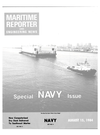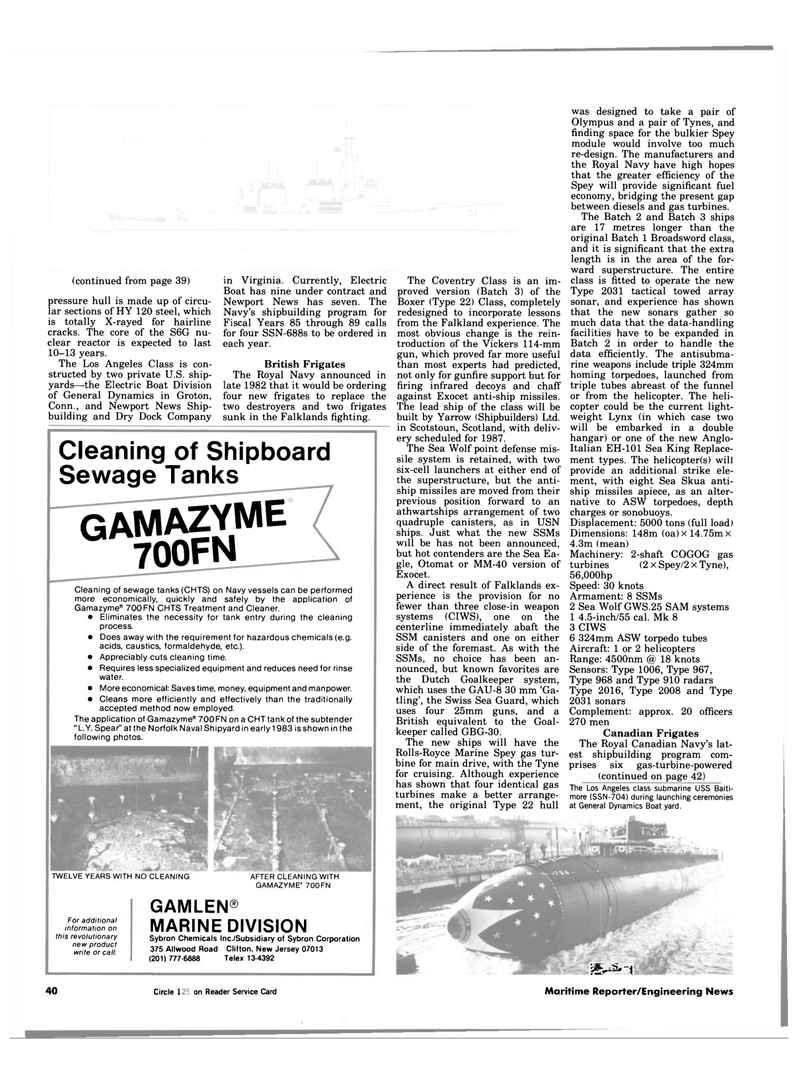
Page 38: of Maritime Reporter Magazine (August 15, 1984)
Read this page in Pdf, Flash or Html5 edition of August 15, 1984 Maritime Reporter Magazine
(continued from page 39) pressure hull is made up of circu- lar sections of HY 120 steel, which is totally X-rayed for hairline cracks. The core of the S6G nu- clear reactor is expected to last 10-13 years.
The Los Angeles Class is con- structed by two private U.S. ship- yards—the Electric Boat Division of General Dynamics in Groton,
Conn., and Newport News Ship- building and Dry Dock Company in Virginia. Currently, Electric
Boat has nine under contract and
Newport News has seven. The
Navy's shipbuilding program for
Fiscal Years 85 through 89 calls for four SSN-688s to be ordered in each year.
British Frigates
The Royal Navy announced in late 1982 that it would be ordering four new frigates to replace the two destroyers and two frigates sunk in the Falklands fighting.
Cleaning of Shipboard
Sewage Tanks
GAMAZYME 700FN
Cleaning of sewage tanks (CHTS) on Navy vessels can be performed more economically, quickly and safely by the application of
Gamazyme® 700 FN CHTS Treatment and Cleaner. • Eliminates the necessity for tank entry during the cleaning process. • Does away with the requirement for hazardous chemicals (e.g. acids, caustics, formaldehyde, etc.). • Appreciably cuts cleaning time. • Requires less specialized equipment and reduces need for rinse water. • More economical: Saves time, money, equipment and manpower. • Cleans more efficiently and effectively than the traditionally accepted method now employed.
The application of Gamazyme® 700FN on a CHT tank of the subtender "L.Y. Spear" at the Norfolk Naval Shipyard in early 1 983 is shown in the following photos.
TWELVE YEARS WITH NO CLEANING AFTER CLEANING WITH
GAMAZYME1 700FN
For additional information on this revolutionary new product write or call:
GAMLEN®
MARINE DIVISION
Sybron Chemicals Inc./Subsidiary of Sybron Corporation 375 Allwood Road Clifton, New Jersey 07013 (201) 777-6888 Telex 13-4392
The Coventry Class is an im- proved version (Batch 3) of the
Boxer (Type 22) Class, completely redesigned to incorporate lessons from the Falkland experience. The most obvious change is the rein- troduction of the Vickers 114-mm gun, which proved far more useful than most experts had predicted, not only for gunfire support but for firing infrared decoys and chaff against Exocet anti-ship missiles.
The lead ship of the class will be built by Yarrow (Shipbuilders) Ltd. in Scotstoun, Scotland, with deliv- ery scheduled for 1987.
The Sea Wolf point defense mis- sile system is retained, with two six-cell launchers at either end of the superstructure, but the anti- ship missiles are moved from their previous position forward to an athwartships arrangement of two quadruple canisters, as in USN ships. Just what the new SSMs will be has not been announced, but hot contenders are the Sea Ea- gle, Otomat or MM-40 version of
Exocet.
A direct result of Falklands ex- perience is the provision for no fewer than three close-in weapon systems (CIWS), one on the centerline immediately abaft the
SSM canisters and one on either side of the foremast. As with the
SSMs, no choice has been an- nounced, but known favorites are the Dutch Goalkeeper system, which uses the GAU-8 30 mm 'Ga- tling', the Swiss Sea Guard, which uses four 25mm guns, and a
British equivalent to the Goal- keeper called GBG-30.
The new ships will have the
Rolls-Royce Marine Spey gas tur- bine for main drive, with the Tyne for cruising. Although experience has shown that four identical gas turbines make a better arrange- ment, the original Type 22 hull was designed to take a pair of
Olympus and a pair of Tynes, and finding space for the bulkier Spey module would involve too much re-design. The manufacturers and the Royal Navy have high hopes that the greater efficiency of the
Spey will provide significant fuel economy, bridging the present gap between diesels and gas turbines.
The Batch 2 and Batch 3 ships are 17 metres longer than the original Batch 1 Broadsword class, and it is significant that the extra length is in the area of the for- ward superstructure. The entire class is fitted to operate the new
Type 2031 tactical towed array sonar, and experience has shown that the new sonars gather so much data that the data-handling facilities have to be expanded in
Batch 2 in order to handle the data efficiently. The antisubma- rine weapons include triple 324mm homing torpedoes, launched from triple tubes abreast of the funnel or from the helicopter. The heli- copter could be the current light- weight Lynx (in which case two will be embarked in a double hangar) or one of the new Anglo-
Italian EH-101 Sea King Replace- ment types. The helicopter(s) will provide an additional strike ele- ment, with eight Sea Skua anti- ship missiles apiece, as an alter- native to ASW torpedoes, depth charges or sonobuoys.
Displacement: 5000 tons (full load)
Dimensions: 148m (oa)x 14.75m x 4.3m (mean)
Machinery: 2-shaft COGOG gas turbines (2 x Spey/2 x Tyne), 56,000hp
Speed: 30 knots
Armament: 8 SSMs 2 Sea Wolf GWS.25 SAM systems 1 4.5-inch/55 cal. Mk 8 3 CIWS 6 324mm ASW torpedo tubes
Aircraft: 1 or 2 helicopters
Range: 4500nm @ 18 knots
Sensors: Type 1006, Type 967,
Type 968 and Type 910 radars
Type 2016, Type 2008 and Type 2031 sonars
Complement: approx. 20 officers 270 men
Canadian Frigates
The Royal Canadian Navy's lat- est shipbuilding program com- prises six gas-turbine-powered (continued on page 42)
The Los Angeles class submarine USS Balti- more (SSN-704) during launching ceremonies at General Dynamics Boat yard. 40 Circle 140 on Reader Service Card 40
Jt~£>: 1
Maritime Reporter/Engineering News

 37
37

 39
39
